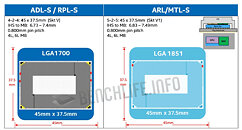
Unreleased Intel Core i9-14900KS Already De-lidded, 10°C Temperature Drop On Offer
Intel may be launching its enthusiast-segment desktop processor, the Core i9-14900KS Special Edition next week, but the chip is already in the hands of several elite overclockers, such as Pakhtunov from OCN. Once he got his hands on one of these, Pakhtunov wasted little time in de-lidding the chip, cleaning it up, grabbing some pics, before throwing it back in the arena for some before-and-after comparisons.
With its stock integrated heatspreader (IHS) in place, a Cinebench 2024 load sees a boost frequency on the P-cores of 5.90 GHz, in which the processor draws a staggering 376 W (as reported by the motherboard's ACPI to software); and a temperature of 85°C, when cooled with a Deepcool LS720 SE 360 mm AIO CLC. With the IHS removed, and at the same 5.90 GHz clocks and Cinebench 2024 load, sees the temperatures drop to 75°C, and power-draw to 366 W. The story repeats with the more brutal Y-cruncher stress test. The original chip with the IHS in place, and a 5.90 GHz boost on the P-cores, pulls a staggering 432 W, and 89°C temperatures. Remove the IHS, and the temperature drops to 82°C, with 409 W package power. It's worth noting here, that with the IHS removed, Pakhtunov used a liquid-metal TIM application between the die and the cold-plate.
With its stock integrated heatspreader (IHS) in place, a Cinebench 2024 load sees a boost frequency on the P-cores of 5.90 GHz, in which the processor draws a staggering 376 W (as reported by the motherboard's ACPI to software); and a temperature of 85°C, when cooled with a Deepcool LS720 SE 360 mm AIO CLC. With the IHS removed, and at the same 5.90 GHz clocks and Cinebench 2024 load, sees the temperatures drop to 75°C, and power-draw to 366 W. The story repeats with the more brutal Y-cruncher stress test. The original chip with the IHS in place, and a 5.90 GHz boost on the P-cores, pulls a staggering 432 W, and 89°C temperatures. Remove the IHS, and the temperature drops to 82°C, with 409 W package power. It's worth noting here, that with the IHS removed, Pakhtunov used a liquid-metal TIM application between the die and the cold-plate.














































